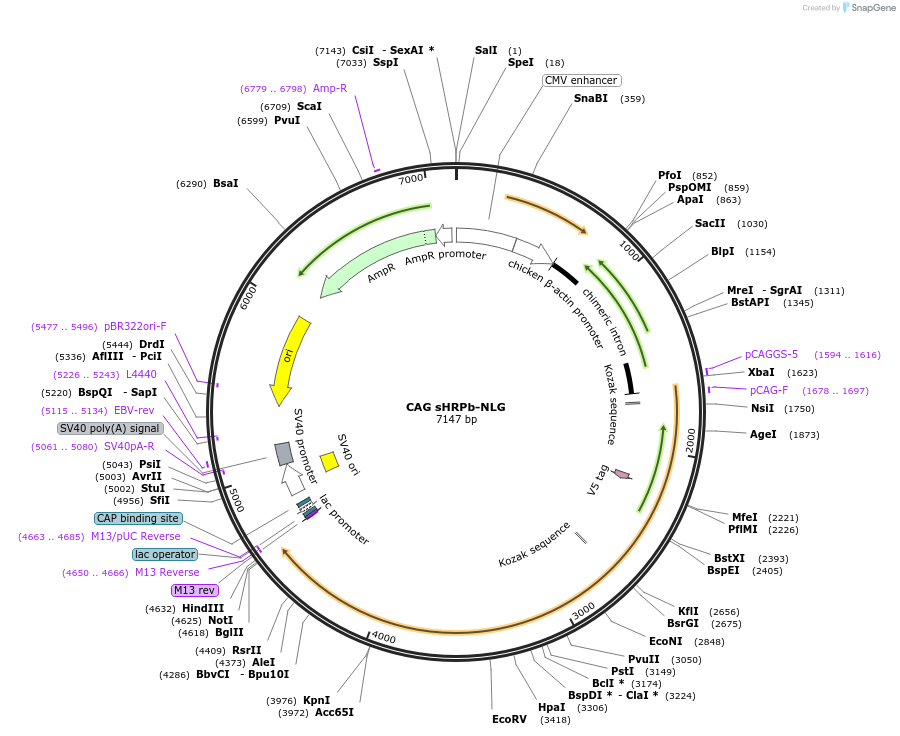-
PurposeSmall fragment of split HRP fused to the extracellular terminus of NLG1. CAG promoter.
-
Depositing Lab
-
Sequence Information
Ordering
| Item | Catalog # | Description | Quantity | Price (USD) | |
|---|---|---|---|---|---|
| Plasmid | 73144 | Standard format: Plasmid sent in bacteria as agar stab | 1 | $89 | |
Backbone
-
Vector backbonepCAG
- Backbone size w/o insert (bp) 4247
- Total vector size (bp) 7147
-
Vector typeMammalian Expression
Growth in Bacteria
-
Bacterial Resistance(s)Ampicillin, 100 μg/mL
-
Growth Temperature37°C
-
Growth Strain(s)DH5alpha
-
Copy numberHigh Copy
Gene/Insert
-
Gene/Insert namesHRPb-NLG
-
SpeciesM. musculus (mouse), Synthetic
-
Insert Size (bp)2886
-
Entrez GeneNlgn1 (a.k.a. 6330415N05Rik, NL1, Nlg1, mKIAA1070)
- Promoter CAG
-
Tag
/ Fusion Protein
- V5 tag
Cloning Information
- Cloning method Restriction Enzyme
- 5′ cloning site AgeI (not destroyed)
- 3′ cloning site MfeI (not destroyed)
- 5′ sequencing primer GCTAACCATGTTCATGCCTTC
- (Common Sequencing Primers)
Terms and Licenses
-
Academic/Nonprofit Terms
-
Industry Terms
- Not Available to Industry
Trademarks:
- Zeocin® is an InvivoGen trademark.
Depositor Comments
sHRPb is the small split HRP fragment. It consists of amino acids 214-308 of horseradish peroxidase (HRP) with the following 2 mutations: N255D, L299R
The insert contains the following features:
EcoRI-NLG1 ss-AgeI-sHRPb-5 aa linker-V5 epitope tag-MfeI-NLG1-stop-BglII-NotI
CAG promoter
5 aa linker: GSGSG
V5 epitope tag: GKPIPNPLLGLDST
NLG: mouse neuroligin1
This construct was derived from the 3xAP-NLG1 plasmid (Addgene ID 43923).
These plasmids were created by your colleagues. Please acknowledge the Principal Investigator, cite the article in which the plasmids were described, and include Addgene in the Materials and Methods of your future publications.
-
For your Materials & Methods section:
CAG sHRPb-NLG was a gift from Alice Ting (Addgene plasmid # 73144 ; http://n2t.net/addgene:73144 ; RRID:Addgene_73144) -
For your References section:
A split horseradish peroxidase for the detection of intercellular protein-protein interactions and sensitive visualization of synapses. Martell JD, Yamagata M, Deerinck TJ, Phan S, Kwa CG, Ellisman MH, Sanes JR, Ting AY. Nat Biotechnol. 2016 May 30. doi: 10.1038/nbt.3563. 10.1038/nbt.3563 PubMed 27240195



